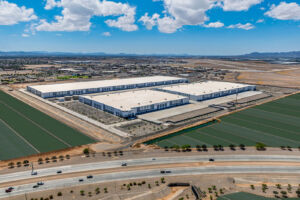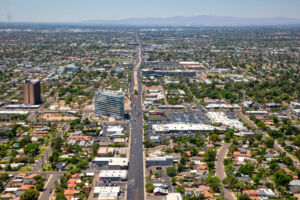A recent report found that Phoenix ranked 7th nationally among the top 10 metropolitan areas for rent growth in Q4 2017. During that time, the city saw a 4.4 percent rate hike, continuing its trend of reported rent increases above 4 percent for almost four years.
State business experts said this hike is a result of a robust apartment market that continues to grow, fueled by an active construction market that keeps up with apartment demand from an influx of new, young residents into the city.
The ranking was reported by RealPage, a property management software provider, which also found that supply for Phoenix multifamily properties, 7,463 units, more than matched the demand of 7,128 units, leading to a 94.4 percent occupancy rate.
Average monthly rent in the city was $994, lower than the $1,330 national average. The economically maturing city is in good company with other large metropolitan areas.
Phoenix sits below Riverside/San Bernardino which saw a 4.7 rent percent growth; above that stands cities like Richmond, Orlando and Jacksonville, Florida, as well as Las Vegas and Sacramento which all experienced a growth rate of 5 percent or more.
RealPage’s findings match figures found in another report compiled by Colliers International in Greater Phoenix, which said asking rental rates rose 6.8 percent in all of 2017.
Colliers’ report found that asking rental rates rose nearly seven percent last year, leaving the average asking rate at $994 and that half of the city’s submarkets have an average asking rate higher than $1,000 per month. During the fourth quarter, vacancy rose 20 basis points to 5.9 percent, 10 basis points below the end of 2016.
These rising rates have also drove up the median investment sales by six percent to over $110,000 per unit, according to the report. The report points to signs of higher vacancy and rent rates.
This uptick has also had a ripple effect on employment in the Greater Phoenix area as 37,300 net new blue-collar and white-collar jobs added in 2017, according to the report. The year before, over 56,000 new positions were created and employers expanded payrolls for more than 56,000 positions.
Pete O’Neil, a research director for Colliers, said two factors that have driven this growth is a consistently low vacancy rates across all properties, despite increased demand across the board. As the number of new properties increase, vacancy rates have remained below six percent, which is a strong sign of this demand, O’Neil said.
But supply has kept up with the pace of that demand, which is largely in downtown Phoenix but also prevalent throughout other submarkets, which he said is a testament to the strength of the construction industry.
“I think what makes Phoenix attractive generally, particularly for business, is where we pull from … because we’re always going to be more affordable than places like (California), even if our prices go up,” O’Neil said.
“If rents or housing prices go up in their current ranges, I don’t think we’re going to necessarily price ourselves out of being affordable.”
Although rates may be high, that doesn’t mean that it’s unaffordable.
These rising prices, which consumers continue to pay, sit lower than many large metropolitan areas like Denver and cities in Southern California. As wages increase, so is the population; Maricopa county alone grows by 100,000 people per year on average because of the creation of these new jobs.
Lee McPheters a research professor of economics at Arizona State University’s W. P. Carey School of Business, said people across the country relocate to Phoenix because it is one of the cheapest metropolitan areas to live in. McPheters said the rising rent is expected but not unreasonable, as more continue to choose to rent apartments rather than homes.
A lot of people who are migrating to Phoenix and in other markets across the nation, McPheters said, are millennials. This group usually does not purchase single family housing and usually favor apartments, putting pressure on apartment markets.
But the market is at a manageable balance right now, he said, and that there is no signs of overbuilding or rents shooting sky-high.
“When you look at Phoenix rents, I don’t think they’re in any way out of whack with what you’d expect to see in a growing economy,” McPheters said.
“Even though rents are going up, it’s a balanced economy reflecting strong population growth, good job growth and the construction industry responding to market signals.”
Trevor Koskovich, executive vice president with Colliers international, said another important factor to consider in the rise of these rental rates is the kind of properties being built, like class A developments.
When added to the rental pool, these low-risk, high rent and low vacancy properties raise the average asking price. But the growth in the rent is also correlated with the increase in minimum wage, Koskovich said.
“As we see wages increase and unemployment continue to diminish, the landlord is going to ask for that money because it costs them more money to operate these buildings,” Koskovich said.
This expansion in rental rates, Koskovich said, is not a “wildly large” number and is near what a “perfect” market would be seeing in annual increases, about 3 percent. Phoenix may be a little ahead of that market, but Koskovich remains optimistic about the market climate and feels this trend will continue as the economy continues to grow.
“I think we do see this trend continuing,” Koskovich said.
“As a general statement, the general macroeconomic factors in the U.S., possibly even a little bit of inflation and things like that will continue to drive the market.



